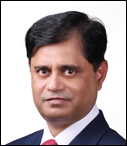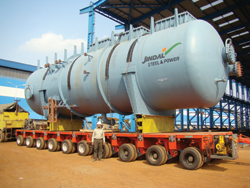 — C.B. Singh, Senior Deputy General Manager – Sales & Marketing, Machinery Division, Jindal Steel & Power Ltd
— C.B. Singh, Senior Deputy General Manager – Sales & Marketing, Machinery Division, Jindal Steel & Power Ltd
Jindal Steel & Power Ltd, a part of the $18-billion O.P. Jindal Group, is an industrial powerhouse with a dominant presence in steel, power, mining and infrastructure sectors. C.B. Singh, in an email interaction with Projectmonitor, talks about the prospects for the heavy engineering and equipment sector in general and for JSPL’s machinery division in the wake of a new government in New Delhi.
Following a new government in New Delhi, what are your expectations for the overall economy and the infrastructure sector in coming months and years?
The GDP growth of India was around 4.7 per cent in the last five years which has impacted the total economy of the country and infrastructure. This was due to various reasons like negligible new projects and less investment by FDI. The new government has come up with a clear majority and as a result we have a stable government. It will attract Indian investors and FDI as well to come up with new projects.
It is expected the growth of the Indian industry will improve due to the initiatives announced in the current year’s budget. Industries like mini steel plant, secondary steel making, and renewable energy sector are looking for attractive schemes from the government.
Do you have a specific wish-list for the government vis-à-vis economic reforms and policy changes that will benefit the heavy engineering and equipment sector?
Presently, there is tough competition amongst the industries of heavy equipment manufacturers. Government, semi-government and leading private companies are considering lowest prices (L1) as the only major criteria while finalising orders and normally ignoring the technological strengths or infrastructure of vendors for realising the orders. Comparisons should be apple to apple for finalising any tender.
Do you face competition from imported Chinese machinery and equipment?
The Chinese machines are quite cheaper but have come up with unreliable performance and uncertain life. They are also not providing after-sales services and spares which in turn lead to frequent downtime and longer repair time. But price being the only criteria for finalisation of the orders, Indian heavy engineering industries lose out on orders against the Chinese.
The government should take steps while allowing China to export engineering equipment to India based on certain critical quality criteria and should enhance custom duty. They may be allowed to have stake in our heavy engineering industries in place of importing from them. This will create opportunities of employment and will reduce the foreign currency outflow.
What are the major areas within your sector that require immediate attention?
 The engineering industries are required to take immediate action for enhancing facilities and capabilities to cope with the forthcoming requirements from sectors like steel, power, mining, infrastructure and others. It is expected that by the end of this financial year many projects in these sectors will get clearance from private and public sectors. So a well-structured and fast-paced capacity enhancement is required by equipment manufacturers. To retain talent is also a challenge for heavy engineering industries because most talent opts for IT and other white-collar jobs. The industry will have to offer attractive packages and amenities to retain competent talent.
The engineering industries are required to take immediate action for enhancing facilities and capabilities to cope with the forthcoming requirements from sectors like steel, power, mining, infrastructure and others. It is expected that by the end of this financial year many projects in these sectors will get clearance from private and public sectors. So a well-structured and fast-paced capacity enhancement is required by equipment manufacturers. To retain talent is also a challenge for heavy engineering industries because most talent opts for IT and other white-collar jobs. The industry will have to offer attractive packages and amenities to retain competent talent.
How competitive are Indian manufacturers of heavy machinery and equipment vis-à-vis their foreign counterparts?
The Indian machines are very competitive with their foreign counterparts where the weightage is given to quality. However, the counterparts are becoming competitive because their governments provide incentives in building heavy machines. Indian heavy industries should also be given similar type of incentives to be more competitive in international markets and to come up in a big way.
Can you highlight some of the latest product trends in machinery and equipment in India?
In many industries which are coming in micro and medium scale are almost in all sectors like power, steel and mining. Therefore, the trends of equipment required are more for these industries. This is because small investors are coming up in these industries like coal-based DRI, pelletisation, iron ore beneficiations, mini power plants, wind energy, solar energy etc.
Which segments of Indian process industries will see bigger demand for heavy machinery and equipment?
Power, steel and infrastructure will have bigger demand for heavy machinery equipment in coming years because India is far behind the world standard in these areas. For meeting the upcoming demand heavy engineering industries will have to plan in advance for infrastructure and high level talent. Further, they will have focus on design and engineering for which we are now buying from other countries. We should have our own technologies or will have to go for short- and long-term technology collaboration, under ‘technology transfer’ condition after term of collaboration is over. Procurement of equipment should be totally stopped.
What is the machinery division’s total order book position and which are some of your key ongoing orders?
The total order booked of the machinery division of JSPL is about 20,000 tonnes which is approximately Rs. 200 crore. This includes the equipment for process industries, EOT cranes, pressure vessels and steel foundry etc.
JSPL’s machinery division has manufactured EOT hot metal cranes up to 500 ton with technology from SIBCRANEX, Russia, and 275-ton ladle turret as per the technology of SMS Concast. We are under finalisation of our long-term collaboration in the area of EOT cranes, port cranes, BMH equipment etc. The Machinery Division is also catering to the needs of industries like SAIL, NMDC, Tata Sponge, BHEL, Danielli, L&T MHI and other public and private sector companies in addition to their own and OPJ Group Co.
The major advantage for clients is the availability of 90 per cent of raw material in-house with the machinery division. They have the objective to enhance their external business up to 50 per cent from the present level of 10 per cent. The Machinery Division has also entered into in-site work and will start the EPC shortly.
Can you briefly talk about the machinery division’s existing plant and capacity, and expansion plans, if any?
The existing planned capacity of the machinery division is 30,000 tonnes and value may be to the tune of Rs. 450-500 crore which is being planned to expand further to Rs. 2,500 crore by year 2020.











